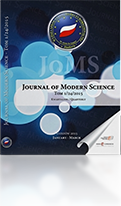Komu Polacy ufają? Analiza wtórna danych ESS 2014
z zastosowaniem analizy czynnikowej, analizy rzetelności oraz analizy wariancji
Who do Poles trust? Secondary analysis of ESS 2014 data using factor analysis, analysis of reliability and analysis of variance
Author(s): Krzysztof DziurzynskiSubject(s): Sociology
Published by: Wydawnictwo Akademii Nauk Stosowanych WSGE im. A. De Gasperi w Józefowie
Keywords: Europeen Social Survey; trust; factor analysis; analysis of reliability; analysis of variance
Summary/Abstract: Trust is a multidimensional variable and a number of one-dimensional variables are needed to measure it. These variables may refer to state institutions, political institutions, people, media, etc. The more variables used to determine the unit level of trust, the harder it is to identify a hidden variable that will replace several one-dimensional variables in further research. Trust is such a hidden variable. Of course, you can ask the question: do you generally trust? The answer to this question is dichotomous: yes or no trust. But will the researcher know who trusts whether it is a person or an institution and what is very important to what degree he trusts.Thus, the seemingly simple research task at the conceptualization stage begins to complicate, grow and make the researcher reach for a more extensive research tool. The presented article will analyze the problems of Poles’ trust. Data comes from the seventh round of the 2014 European Social Survey. 1616 people aged over 16took part in it. The obtained results were subjected to analysis allowing to determine multidimensionality (factor analysis) and scale reliability (Cronbach’s alpha). As the main cognitive goal, the determination of the perception of the dimensions of trust was accepted. Originally, it was assumed that five one-dimensional variables would allow the reproduction of two latent variables (components) that would simplify the analysis of trust. It was also assumed that (1) sex, (2) age, (3) education and (4) place of residence will significantly differentiate the level of trust. It was also decided to present the level of confidence of Poles against the background of other countries participating in the ESS
Journal: Journal of Modern Science
- Issue Year: 37/2018
- Issue No: 2
- Page Range: 95-115
- Page Count: 21
- Language: Polish

